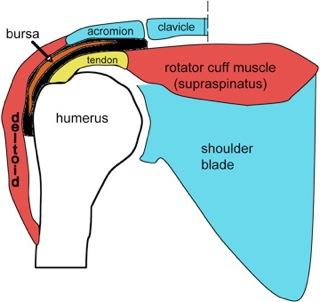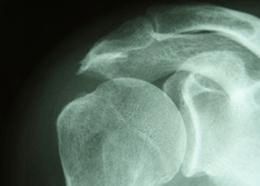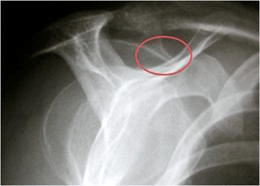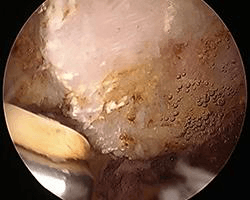Shoulder Impingement
What is Shoulder Impingement?
Shoulder impingement is also called subacromial bursitis, swimmer's shoulder, tennis shoulder, or rotator cuff tendinitis. It is the condition of inflammation of the tendons of the shoulder joint caused by motor vehicle accidents, trauma, and while playing sports such as tennis, baseball, swimming and weight lifting.
Individuals with shoulder impingement may experience severe pain at rest and during activities, weakness of the arm and difficulty in raising the hand overhead.
Causes of Shoulder Impingement
Normally, the rotator cuff tendons can easily slide under the acromion each time your arm is raised; however, it is normal to have some degree of rubbing or pinching of the tendons and bursa.
The insufficient room between the acromion and the rotator cuff can cause impingement. This results from pressure on the rotator cuff from part of the shoulder blade (scapula) as the arms are lifted.
Overuse of the shoulder in an elevated position can cause the impingement to become a problem and can lead to ongoing pain or damage to the rotator cuff tendons.
- Using arms overhead
- Repetitive lifting
- Result of a minor injury
In some circumstances, a partial tear of the rotator cuff may cause impingement pain.
Anatomy of Shoulder Impingement
The shoulder is a complex ball-and-socket joint that allows full movement of the arm. It offers a wide range of motion, but also makes it vulnerable to injury.
At the shoulder, three major bones meet and create a 90-degree angle. These bones are the
- collarbone (clavicle)
- the shoulder blade (scapula)
- humerus, the largest bone of the arm.
Three joints are formed from the junctions of these three bones and the sternum. These joints are the
- glenohumeral joint,
- acromioclavicular (AC) joint and
- sternoclavicular joint.
Each joint in the shoulder is surrounded by cartilage for padding, ligaments to connect the bones, muscles and tendons to attach the muscles to the bones.
Who Are Commonly Affected by Shoulder Impingement?
Shoulder Impingement is more likely to occur in young and middle-aged people who engage in physical activities that require repeated overhead arm movements.
The condition is common in
- A sport such as: tennis, golf, swimming, weight lifting, or throwing a ball.
- Work that requires repeated overhead lifting or work at or above shoulder height is also at risk of rotator cuff impingement.
The pain may be due to "bursitis" or inflammation of the bursa overlying the rotator cuff or a "tendonitis" of the cuff itself.
Shoulder Impingement can also be caused by age-related degeneration.
What Are the Symptoms of Shoulder Impingement?
Individuals with shoulder impingement may experience severe pain at rest and during activities, weakness of the arm and difficulty in raising the hand overhead.
Sufferers of Shoulder Impingement may have the following symptoms
- Minor pain, present with activity and rest
- Pain radiating from the front of the shoulder to the side of the arm
- Pain with lifting and reaching movements
- Pain at night
- Loss of strength and motion
Shoulder Impingement caused by bursitis may include:
- Pain around the outside or tip of the shoulder
- Pain when the shoulder is touched
- Reduced range of movement in the shoulder joint
- Swelling and redness around the shoulder
- Shoulder pain when the arm is raised, such as reaching shelves or washing hair
The pain may become worse at night, especially when lying on the affected shoulder. It may also get worse after the shoulder has been kept still for a while.
If the above symptoms are coupled with a fever, the bursa may be infected. This is called septic bursitis, and a doctor should investigate the situation.
How is Shoulder Impingement Diagnosed?
While not all of these diagnostic approaches or tests are required to confirm the diagnosis, the diagnostic process will allow your surgeon to review any possible risks or existing conditions that could interfere with the surgery or its outcome.
Consultation
During this consultation, your surgeon will:
- take a medical history,
- physical examination by your surgeon - Often Shoulder Impingement can be identified during a physical exam by your surgeon. By examining the joint, the cause of symptoms can be pinpointed.
- assessment of the range of movements and strength of the affected shoulder, and
- look for other associated causes of shoulder pain.
Imaging tests
In order to clearly understand the nature of any loss of the joint space or bone spur formation. If imaging scans are required they can include:
- Ultrasound – This is a useful first-line test to help assess the amount of subacromial bursitis or the presence of any rotator cuff tear
- X-rays – Since x-rays do not show the soft tissues of your shoulder like the rotator cuff, plain x-rays of a shoulder with rotator cuff pain are usually normal or may show a small bone spur. Occasionally you can see calcific deposits in the tendon, related to a condition called calcific tendinopathy. A special x-ray view called an "outlet view," sometimes will show a small bone spur on the front edge of the acromion.
- MRI - can create more detailed images of your shoulder’s soft tissues. An MRI can produce cross-sectional images of internal structures such as the labrum (link back to labral tear), cartilage and rotator cuff if the diagnosis is unclear.
Arthroscopy
Where appropriate an Arthroscopy may be performed.
X-rays showing changes to the acromion that narrow the tendon tunnel.
How Can Shoulder Impingement Be Treated?
Treatment typically involves:
- resting the affected joint and
- protecting it from further trauma.
In most cases, bursitis pain goes away within a few weeks with proper treatment, but recurrent flare-ups of bursitis are common. When deciding on the appropriate treatment for Shoulder Impingement Your surgeon will consider your age, activity level and general health.
Non Surgical Treatment
- Activity Modification: avoiding tasks that exacerbate the pain.
- Pain Management: Analgesics, Non-steroidal anti-inflammatory medication and cortisone injections
- Physical therapy: with emphasis on restoring shoulder movement and strength.
Surgical Treatment
Shoulder Impingement Surgery
Shoulder Impingement surgery may improve function and reduce pain to the shoulder joint. It may also reduce tendon damage and progression to tendon tear. Shoulder Impingement surgery was traditionally performed as open surgery, with long incisions, muscle detachment and a long recovery process.
Minimally Invasive Shoulder Surgery
Shoulder Impingement surgery can now be performed as a keyhole ( arthroscopic) procedure. Two or three small incisions (portals) are made. Each incision is called a portal.
In one portal, the arthroscope (camera) is inserted to view the shoulder joint. Along with the arthroscope, a sterile solution is pumped to the joint which expands the shoulder joint, giving the surgeon a clear view and room to work.
Images from the arthroscope are transmitted to a large television screen that allows the surgeon to assess the structures of the shoulder joint. The inflamed bursa is removed. The abnormal bone spur is removed with a high speed burr.
Arthroscopic images showing bone spur and its removal.
The integrity of the rotator cuff tendons is confirmed. Occasionally unexpected pathology such as a degenerate biceps tendon may be found that may require additional surgery.
Untreated Shoulder Impingement
Shoulder Impingement is not life threatening but can impact on a patient’s quality of life and function. It can affect anyone: elite athletes and the active individual, manual labourers and office workers.
Shoulder Impingement can lead to
- Short Term: inflammation of the bursa and rotator cuff abrasion. .
- Long Term: rotator cuff tendons may thin, laminate and tear.










